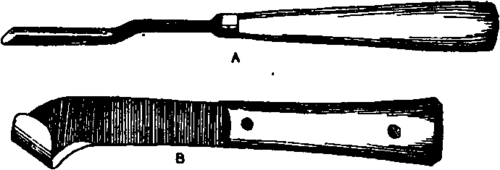The Paring Process
Description
This section is from the book "Rubber And Rubber Planting", by R. H. Lock. Also available from Amazon: Rubber And Rubber Planting.
The Paring Process
The actual process of tapping is as follows. The opening cuts are narrow grooves cut in the outer bark and extending to within about one-eighth of an inch of the cambium. It is important that the depth of the groove should be exactly the same throughout its length. The distance from the cambium can be gauged by pricking with the blade of a pen-knife. Further tapping consists in removing a thin shaving from the lower side of the original groove on each occasion, always to exactly the same depth. Coolies soon become very expert at this work, but constant supervision is necessary in order that no damage may be done. If the tapper makes a mistake and cuts too deeply, injuring the cambium, he should" be instructed to make three or four very shallow cuts immediately below the wound, so as to leave a thick piece of bark from which healing can take place. If tapping is continued to the normal depth no matter how carefully it is conducted the wound is almost certain to spread. In the best tapping the cuts are made to slope slightly inwards in order to form a suitable groove by which the latex can reach the conducting channel. The latex may need a little encouragement before it will flow smoothly in the right direction, without overflowing the channel. The merits of good tapping consist in taking off the thinnest possible shavings compatible with a free flow of latex and preserving an even depth of cut, close to the cambium but never touching it. The cuts should be as clean and as sharp as possible.
Tapping Tools
Of tools used in paring there is a great variety upon the market* Many of these are highly effective, and it is not our business here to puff the goods of any particular maker. The writer's view is that the simplest tools are the best, and that a great deal is to be said for the original and primitive forms the gouge and farrier s knife or slight modifications of these Such tools are very widely used in the Malayan plantations, but the Ceylon planter seems generally to prefer a more complicated weapon. The simpler tools may necessitate greater care at first on the part of the tapper, but once the requisite skill is attained, the greater adaptability of the simpler tool and the greater ease with which it can be kept sharp, enable the worker to preserve a very straight line and to remove a very thin shaving, keeping at the same time an accurate depth of cut.

Fig. 21. Gouge and Farrier's knife.
Continue to:
